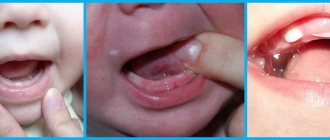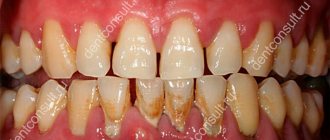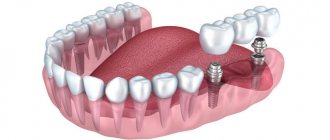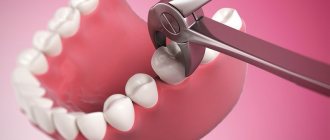From this article you will learn:
- types of professional and home whitening,
- which method is better and safer,
- teeth whitening in St. Petersburg and Moscow – prices 2022.
The article was written by a dentist with more than 19 years of experience.
Cosmetic teeth whitening can be professional, in which case it is performed in a dental clinic, or at home, using at-home products (for example, Crest whitening strips, Opalescense whitening gel, and special toothpastes).
As a dentist, I have to admit that home remedies for teeth whitening are becoming more effective every year. Already today, some of them allow you to achieve results that are quite comparable to the effectiveness of professional teeth whitening techniques - such as “Zoom”, “Beyond Polus”, “Opalescence Boost”, etc.
There is a lot of misinformation being circulated regarding professional and home whitening. For example, you will never be able to lighten your teeth by 8-12 shades - which is what they constantly say in advertising. The real result is 4-6 tones on the VITA scale (Fig. 2). And besides, whitening is not as safe for the hard tissues of teeth as they try to make it out to be.
In this article we will talk about the pros and cons of all the main methods of home and professional whitening, compare their cost and effectiveness. Below you can read reviews on teeth whitening, as well as see “before and after” photos of various whitening techniques.
Where to get laser teeth whitening in Moscow?
At the PROFI-Dent dental clinic!
This is a safe, painless and effective procedure that will give your teeth a pearly shine. A brilliant smile has always been the standard of beauty, and if you want to get it quickly and without harm to your health, laser whitening is the best solution of all!
The result of the procedure is a gorgeous snow-white smile!
Professional teeth whitening at the dentist –
Today there are 3 main types of professional whitening. The first two methods: photo whitening and laser teeth whitening imply that, in addition to the whitening gel, a special light source (laser or special whitening lamp) will also be used. The third method, when only whitening gel is used, is no less effective.
Today, the most popular in-office whitening methods are “Zoom” (Fig. 4-6) and “Beyond Polus”. These are photo teeth whitening techniques that involve the use of not only a gel with hydrogen peroxide during the procedure, but also a special whitening lamp. Such lamps do not have their own whitening effect and are designed to increase the rate of breakdown of hydrogen peroxide into free radicals.
Zoom-4 lamp and whitening kit –
Clinical teeth whitening at the dentist has undeniable advantages. First of all, it requires only 1 visit to the dentist, and the duration of the procedure takes only 1 hour - in contrast to the long daily use of home whitening systems for 10-20 days. In addition, the procedure itself takes place under the supervision of a dentist, which reduces the risk of side effects and increases the effectiveness of the procedure. But, in principle, this is where the advantages end.
In terms of effectiveness, the effectiveness of professional and home whitening systems is almost equal. This turned out to be possible thanks to the fact that many high-quality foreign manufacturers of dental materials, along with professional whitening systems for dentists, began to produce kits for home whitening - such as “Opalescense” and “Perfect Bleach”. They are produced by such well-known manufacturers of dental materials as ULTRADENT (USA) and VOCO (Germany).
Thus, in both home and professional systems, in principle, the same technologies are used. In addition, we must admit the following: statements by dentists that professional whitening leads to teeth lightening by 8-12 shades, and that the effect lasts for 3-5 years - all this has nothing to do with reality and is largely advertising. And that's why…
→ Reviews about the Zoom-4 whitening method
Teeth whitening before and after: photo
Below you can see what real results of professional whitening can be achieved (without editing before and after photos in Photoshop).
Significant disadvantages of professional whitening –
- The degree of whitening will be lower than expected - the dentist will measure the color of your teeth using a special Vita scale - before and immediately after the whitening procedure.
The problem is that teeth lose a lot of moisture during whitening, and overdried teeth always look whiter than they actually are. Therefore, the color that you see immediately after the procedure will only be temporary. Within 24-48 hours, when the hard tissues of the teeth are saturated with water contained in the oral fluid, the color of the teeth will become much darker than what the dentist will measure for you on the Vita scale. If your dentist persistently guarantees that your teeth will be brightened by 6 or 8 tones, then ask him to measure the color of your teeth not immediately after the procedure, but after 1-2 days, and ask him to include this clause in the contract for the possibility of a refund. Believe me, the dentist’s mood will immediately change... - Duration of the whitening effect - when they tell you that the whitening effect will last for several years - all this is not entirely true.
The fact is that there is a direct relationship: the shorter and more aggressive the whitening procedure, the faster the color will “rebound” back. That is why, after completing the in-office whitening procedure, the dentist will strongly recommend purchasing a home whitening system from their clinic (to maintain its results). Without this home whitening system, the color of your teeth will quickly return, and within 3-5 months the effect will no longer be noticeable at all. The duration of the effect when using home whitening products (such as whitening strips or trays) will be significantly longer, because Such remedies are used over a course of 10 to 20 days and the effect is achieved gradually. - Cost of Teeth Whitening – Professional teeth whitening costs significantly more than home whitening. For example, teeth whitening like “Zoom!” will cost you an average of 15,000 rubles. But in addition, you will have to plan on spending on a home whitening system to support the results of office whitening, which will cost you up to 15,000 rubles (if purchased at a dental clinic.
- Frequent side effects – because.
In a 1-hour procedure, it is necessary to achieve significant teeth whitening - professional whitening will naturally be very aggressive. Only 55% of patients who have undergone professional whitening have positive reviews. The most common complication is shooting pain in the teeth, which can last from several days to several weeks, and taking tablet analgesics practically does not help reduce the pain. That is why teeth whitening at the dentist is contraindicated for people with hypersensitive teeth. In such patients, acute pain occurs already during the procedure, which often leads to the need to stop the whitening procedure without completing it. If your teeth react to thermal or mechanical irritants, you should not do whitening in principle, no matter how much the dentist persuades you (motivating that teeth remineralization courses before and after the procedure will help prevent this). They won't help.
Equipment
Types of laser teeth whitening vary depending on the equipment used. The use of the revolutionary Doctor Smile system (Italy), based on the impact of diode lasers, allows you to:
- Ensure a uniform and gentle effect on tooth enamel, eliminating the risk of overheating and other possible complications.
- Even patients with highly sensitive teeth should visit her.
- Achieve maximum results by lightening the enamel by 6-8 tones or more in just one visit.
Main indications
The appearance of teeth is affected not only by external reasons (smoking, caries, coffee), but also by internal ones (age-related changes, tooth wear, cracks, pigmentation). Modern technologies make it possible to quickly and painlessly eliminate age-related darkening of enamel, remove plaque that occurs due to the consumption of coloring foods and drinks, and lighten teeth darkened due to smoking.
Long-term whitening is especially important for people whose work involves constant contact with other people when they need to show off their smile. An attractive appearance not only gives you self-confidence, but also increases the loyalty of potential customers.
The effect of the procedure lasts for 2-3 years, depending on the individual characteristics of each patient.
How is the procedure performed?
Consultation with a dentist
Analysis of the condition of enamel and dentin
Professional cleaning
Removal of all deposits, including tartar
Laser teeth treatment
With application and removal of special gel
A special gel-like composition is applied to the tooth enamel. Under the action of a laser beam, the active substance is released, penetrates deeply into the enamel and removes stubborn pigments that worsen the color.
All necessary manipulations take on average about 1.5 hours. At the same time, one procedure provides lightening of 6-8 shades even in the most complex cases of enamel pigmentation.
Dental care after the procedure
The final color will appear only after a week, so immediately after the procedure it is important to consolidate the result. For several days after the procedure, it is recommended to follow a “white” diet, that is, exclude from the diet all foods with coloring pigments. These include: red wine, strong tea, coffee, fruits, berries, food with food coloring.
During the week, it is better not to smoke or consume alcoholic beverages, coloring foods and drinks. Take care of your tooth enamel regularly. To brush your teeth (twice a day), choose a suitable brush and toothpaste. The attending physician will give recommendations.
The cost of the procedure is fully paid for by the therapeutic and aesthetic effect, safety, and long-term preservation of the whiteness of the enamel. It is necessary to choose a clinic wisely and carefully after reading reviews . Pay attention to the experience and qualifications of the doctor. Our clinic offers the most innovative technologies for maintaining dental health.
Indications and contraindications
The main indication for laser teeth whitening is darkening of the enamel and its unaesthetic tint!
This procedure has a minimum of contraindications:
- pregnancy;
- individual intolerance to the components of the gel;
- fluorosis;
- age up to 16 years.
Since modern laser technologies make it possible to select the most accurate parameters for the intensity and duration of the beam in each clinical case, the possibility of thermal damage to dental tissues and gums or the occurrence of discomfort during the procedure is completely excluded.
Teeth whitening products at home –
Home teeth whitening products also contain hydrogen peroxide or carbamide peroxide as active ingredients, i.e. in this they are no different from professional whitening products. The difference lies only in the concentration of active components, which in this case will be 2-3 times lower. Lower concentrations are compensated by frequency of use, and the average course of home whitening lasts from 10 to 20 days.
Accordingly, you should be prepared for the fact that the visible effect will become noticeable only on days 3-5 (from the start of the home whitening course). When choosing teeth whitening products at home, you will have to make a compromise between convenience and effectiveness. The most convenient way is to use special whitening strips, the most effective is to use special dental trays and whitening gel. As for whitening toothpastes, their effect will be minimal (on average only 1 tone).
Using whitening strips –
In Russia, the best brands of whitening strips are “Crest 3D White” and “Blendamed 3D White Luxe”.
Both brands are owned by (USA). There is a whole line of Crest strips, which differ from each other mainly only in the concentration of hydrogen peroxide - from 9.5 to 14%. Blendamed strips contain only 5.25% peroxide, and are also quite poorly fixed to the teeth. The hydrogen peroxide whitening gel is applied to the inside of the strips, and all you have to do is apply them to your teeth and press. Next, the strips should remain on the teeth for 30 to 60 minutes (depending on the concentration of hydrogen peroxide). Depending on the type of strips, procedures are done daily 1 or 2 times a day for 10-20 days.
→ Reviews of the use of Crest whitening strips
Important: it should be noted that this type of whitening is more suitable for patients with straight teeth, and is not very suitable for patients with crowding, severely inclined teeth... With uneven teeth, the strips are very difficult to adapt so that they fit evenly and tightly to the teeth. In places where the strips do not fit well, the tooth enamel will remain the same color and will look like dark spots. Crest “FlexFit®” strips will provide the best fit to uneven tooth surfaces.
Using dental trays and whitening gel –
This type of home whitening is the closest in effectiveness to professional whitening, but at the same time has a significantly lower price. The most effective option would be to use Opalescence PF whitening gel containing 10%, 15% or 20% carbamide peroxide (Fig. 11). The cost of Opalescence PF is from 4,300 rubles, however, this whitening option will require the production of individual whitening trays from the dentist (Fig. 12), the cost of which will be about another 3,000 rubles.
Moreover, such individual dental trays can be used repeatedly and for repeated whitening courses. The second option for the lazy is to use universal Opalescence “TresWhite Supreme” dental aligners, which are already pre-applied with a whitening gel based on 10% hydrogen peroxide (Fig. 13). Thus, you no longer need to make additional mouth guards, and all the fun will cost you only 4,500 rubles.
Important: the use of Opalescence “TresWhite Supreme” dental trays already filled with whitening gel is quite effective and, most importantly, convenient. You only need to bite the mouthguard with your teeth, then remove the hard outer layer, and press the inner translucent layer of the mouthguard with your fingers to your teeth (wear for up to 60 minutes). However, if you want to get the maximum effect, then Opalescence PF is the best home teeth whitening product. The custom tray option allows you to use the most effective “overnight” whitening option, where the trays remain on your teeth all night.
→ Reviews on the use of Opalescence dental aligners
Use of whitening toothpastes –
Toothpastes are the weakest method of teeth whitening, and do not make them lighter by more than 1-2 shades. Moreover, the most effective whitening pastes are those containing carbamide peroxide, i.e. they also implement a chemical bleaching mechanism. There are only a few pastes containing carbamide peroxide on the Russian market, the cost of which ranges from 350 to 1450 rubles.
The largest group of whitening toothpastes are those with a high content of abrasives. Such pastes make teeth lighter by allowing them to “scrape” external impurities from the surface of the teeth. But such pastes are not capable of changing the color of the actual dental tissues (24stoma.ru).
→ Rating of whitening toothpastes 2022
Home teeth whitening: before and after photos
How much does laser teeth whitening cost in Moscow?
The cost of laser teeth whitening depends on the volume of work and the number of units. Quick results and absence of discomfort are the main advantages of the procedure.
| The price for laser teeth whitening in Moscow at the PROFI-Dent clinic is in the budget range and is affordable to any patient. | |
| Whitening 1 tooth | 1,500 rubles |
| 20 dental units in the smile zone | 22,000 rubles |
| Air Flow plaque removal (1 jaw) | 1,600 rubles |
How does the procedure work?
Dentists recommend the following preparatory measures before laser whitening:
- cleaning teeth from plaque using ultrasonic and Air-Flow methods
- treatment of gums in the presence of diseases;
- polishing teeth with a special paste containing abrasive particles;
- patient instruction.
Laser teeth whitening is a professional technology, so it is carried out only in an equipped clinic. The procedure itself consists of several stages:
- examination of the oral cavity by a specialist, detection of problems that require immediate solutions, exclusion of possible contraindications;
- preparation of the working cavity and isolation of surrounding tissues (for this, protective glasses for the eyes, lip holders, liquid photopolymer for the gums or a special latex scarf - rubber dam are used);
- preparing a whitening gel and applying it to the teeth (it is painted in a bright color, which allows the doctor to see the distribution of the composition over the surface of the teeth);
- activation of the gel using laser radiation (one session lasts 10-12 seconds, each tooth is illuminated by a laser, without overheating the surface of the teeth and pulp);
- using pressurized water to thoroughly remove the gel (using a saliva ejector);
- removal of insulating means and holders;
- fluoridation of the surface of teeth.
At the last stage, fluoride varnish is applied to the hard tissue of the teeth: this is a painless completion of the procedure. It gives teeth a natural shine and a healthy appearance. The gel, after penetrating into the dental tissue, remains active for several more days, cleaning their surface from remaining pigments and healing the teeth.
see also
Home teeth whitening system – Day White and Night White
Teeth whitening Zoom 4 (Zoom 4)
Deep fluoridation of teeth
Home teeth whitening with trays
Air Flow teeth cleaning
Teeth whitening Opalescence BOOST
Ultrasound teeth cleaning
Hygiene and prevention
Laser lip frenuloplasty
Laser plastic surgery of the frenulum of the tongue
Vestibuloplasty with laser
Laser gingivectomy
Laser dentistry
Teeth Whitening Pencils
A whitening pencil is a small tube with an enamel-lightening component, which is distributed over the surfaces of the teeth with a brush or sponge. The hydrogen peroxide content in lightening pencils is quite low - no more than ten to fifteen percent, but this is enough to severely burn the soft and sensitive tissues of the mouth if used incorrectly. It is almost impossible to choose the right pencil based on peroxide concentration on your own, since each person has individual indicators of the density of the enamel layer and sensitivity. Therefore, it is also impossible to predict negative consequences after using a whitening pencil.
If you decide to try this particular product, we advise you to choose a product with a lower concentration of hydrogen peroxide and be careful when applying it.
Instructions for using teeth whitening pencils are quite simple:
- Before using the pencil, be sure to clean your teeth with regular toothpaste and then rinse your mouth thoroughly.
- Wipe dental surfaces dry with a sterile cloth.
- Treat the surface of the teeth with whitening gel.
- After the procedure, you should not close your mouth for 7-10 minutes (exact instructions should be read in the instructions for the specific product).
After the specified time has passed, the mouth and teeth must be cleaned of any remaining gel. Pencils, like strips, are recommended to be used in a course of two weeks. It is also worth knowing that the effectiveness of using pencils will greatly depend not only on the individual characteristics of a person’s tooth enamel, but also on the presence of a number of bad habits.
Preparation for laser whitening
A week before the procedure, you need to visit the dental clinic for a consultation. During this visit, the dentist will examine the oral cavity, assess the condition of the enamel and gums, and determine any contraindications. If caries is present, therapeutic treatment is prescribed.
Laser whitening cannot be performed if there are carious lesions in the dentition. Oxygen atoms will penetrate deep into the tooth tissue through carious cavities, reaching its nerve, causing severe pain. Subsequently, such exposure will accelerate the process of tooth decay. To avoid this, laser whitening is carried out only after sanitation (treatment) of the oral cavity. After examination and treatment, the patient undergoes hygienic cleaning, during which pigment plaque and tartar are removed. Dental plaque makes our teeth several shades darker. Professional cleaning allows you to determine their natural color. Upon completion of the procedure, fluoride-containing solutions are applied to strengthen the enamel. After hygienic cleaning, several days must pass for the soft tissue of the gums to recover from microtraumas received during the cleaning process. After which you can begin laser whitening.
Advantages and disadvantages of laser whitening
The procedure is very popular among patients because:
- this is a safe way to lighten your smile up to 10 shades,
- laser whitening does not take much time, one session will take about an hour,
- the laser beam gently affects the tooth tissue,
- During the whitening process, teeth and soft gum tissues do not heat up,
- the result obtained can last up to 7 years,
- During the whitening process, the laser beam disinfects the enamel and thickens it.
The disadvantages of this method include:
- possible tingling sensations during the laser whitening process,
- possible increased tooth sensitivity after the procedure,
- the over-whitening effect that occurs if you whiten your teeth frequently,
- relatively high cost of the service.
Should you whiten your teeth with laser?
Whitening is only a cosmetic procedure, and you need to remember this. Before the procedure, it is necessary to sanitize the oral cavity, get rid of all diseases and only then begin whitening.
An important factor is the discomfort that occurs after surgery. For each person, the process of restoring the top layer of enamel proceeds differently. Some people experience only mild sensitivity for a few days after surgery, but there are also cases where people experience pain when eating hot food and drinks for a long time.
In any case, teeth whitening using a diode laser is the most technologically advanced and safe compared to other methods. With proper supervision, the doctor is able to minimize the negative effect of the procedure, and all you have to do is take timely care of your oral cavity.
Many people have high expectations regarding the final result. Many women look at the smiles of Hollywood actresses and want the same sparkling teeth for themselves, but this effect is achieved not only by whitening. For this purpose, veneers are often used, which are placed on top of natural enamel.
It is also worth thinking carefully about the extent to which you are going to whiten your teeth. Pure white looks unnatural and often spoils the smile. In addition, deep whitening requires multiple procedures, which leads to greater damage to the enamel.
To whiten teeth or not - everyone decides for himself. There are times when the dirty color of tooth enamel irritates a person. Here, a cosmetic procedure can really save the situation, but whitening is expensive, and the effect may not be what you expect.
Sources used:
- Therapeutic dentistry, E. V. Borovsky et al., Moscow., 1998
- Statement on Lasers in Dentistry / From the ADA Council on Scientific Affairs. American Dental Association
- Oral hygiene / Yu.A. Fedorov. — M.: Medicine
What to expect after home treatments
Many people understand that the best teeth whitening is the one that is performed under the strict supervision of a dentist. But sometimes you really want to try more budget-friendly solutions, so it’s important to know how many shades you can lighten your teeth using various home remedies, and how long the effect lasts after that. Let's talk.
The best whitening effect is provided by all sorts of strips, pencils and gels (used in conjunction with trays). They allow you to lighten the enamel by 3-5 tones, but only on condition that you have undergone thorough preparation for the procedures, and this or that product has been selected by the dentist taking into account the clinical situation. With careful oral care, positive results can be maintained for the next 6-12 months.
For whitening, the tray is filled with a special whitening composition
Whitening pastes and brushes allow you to achieve changes of 1-2 shades. However, numerous reviews say that the effect disappears immediately, as soon as you stop using these products. They cannot be used on an ongoing basis, otherwise they can make the enamel very thin and sensitive.
Those who prefer to limit themselves to traditional products, such as salt, soda, activated carbon and lemon, should not expect that their teeth will change much. Yes, if the color is initially not very dark and there is no mineralized plaque, the procedures are carried out systematically (1-2 times a week for a month) and all restrictions are observed during this period (quitting smoking, “white” diet), it is possible to whiten the enamel by 1 , maximum 1.5-2 shades. But it will not be possible to maintain the result for longer than 2-4 weeks even with very careful hygienic care of the oral cavity.
Factors on which the durability of the snow-white shade of enamel depends
- the chosen bleaching method and the number of tones that managed to change the shade of the enamel. The initial color of the teeth, as well as the clinical situation of the patient, also plays a great role.
- adherence to the “white” diet: it must be followed during the first 5-14 days after whitening procedures. But even after the enamel is restored and loses its excessive sensitivity, you should not rely on foods and drinks that can lead to permanent staining,
The “white diet” after the whitening procedure will preserve the results for a long time - A reasonable approach to teeth whitening: you should not resort to serious procedures more than once a year, since you still won’t achieve the best effect, but you can weaken the enamel, and then it will become even more susceptible to external influences and dyes. But it is allowed to use professional products that support results (for example, Zoom Day White), but not earlier than 3 months after the main whitening procedure,
- thorough oral care: your arsenal should include all the variety of products necessary for comprehensive home care (brush and paste, floss, irrigator, rinse suitable for the clinical case). You should not skip a single brushing of your teeth, and procedures should be carried out daily, morning and evening,
Using an irrigator will help maintain the achieved result. - removing food debris after eating: you should make it a rule to rinse your mouth with water or mouthwash so that plaque does not accumulate there,
- timeliness of professional oral hygiene: the procedure must be performed 1-2 times a year (if indicated and more often), otherwise a dense mineralized plaque will appear on the teeth, spoiling the aesthetics of the smile and leading to periodontal diseases,
- giving up bad habits: of course, we are talking about smoking, not only classic tobacco products, but also various vapes and electronic cigarettes, which are refilled with cartridges containing color dyes.
You should give up bad habits
After teeth whitening, you should be very careful when choosing personal hygiene products. For example, the same rinses. Many rinses contain dyes, as well as chlorhexidine, which can cause yellowing of the enamel. It is better if the products are recommended by a doctor.
Notice
: Undefined variable: post_id in
/home/c/ch75405/public_html/wp-content/themes/UltraSmile/single-item.php
on line
45 Notice
: Undefined variable: full in
/home/c/ch75405/public_html/wp-content /themes/UltraSmile/single-item.php
on line
46
Rate this article:
( 1 ratings, average: 5.00 out of 5)
whitening
- Zh. B. Sabdenova. Professional clinical teeth whitening // Medicine and ecology. – 2011.
- Lutskaya I.K. Current state of the problem of teeth whitening // International reviews: clinical practice and health. – 2022.
- Tuletaev A.A. Teeth whitening in 60 minutes // Bulletin of Surgery of Kazakhstan. – 2012.
Expert “It is important to understand that achieving the maximum possible effect that one or another professional (and non-professional) whitening method is capable of can only be achieved with careful preparation, which must include professional oral hygiene. During this procedure, soft and hard plaque is removed, the enamel is leveled, polished and strengthened.” Implant surgeon, periodontist Aida Vladimirovna Dzhutova
Consulting specialist
Varlamova Tatyana Vitalievna
Specialization: Dentist-therapist Experience: 6 years
The difference between laser whitening and photo whitening
These two professional whitening techniques are very similar to each other. The main difference between them is the way the whitening gel is activated. The photobleaching gel is activated using ultraviolet lamps. Their rays should act on the whitening gel for 15-20 minutes. Ultraviolet rays during whitening heat the gums and teeth, which causes some discomfort to the patient and can subsequently lead to overheating of the pulp. In the case of laser whitening, each tooth is exposed for 30 seconds, so its tissues do not overheat. In this case, the dentist can change the intensity of the laser beam, taking into account the condition of your enamel. The main advantage of laser whitening is the ability to individually select the whitening composition, intensity and time of exposure to the laser beam. Thanks to this, laser whitening is a safer technique than photo whitening. Read reviews about these procedures and see for yourself.
Is teeth whitening safe: reviews
Below we will list several important points that will be useful for you to know when deciding whether to undergo whitening in principle. In general (when performed correctly and accurately), whitening is a fairly safe procedure if performed in patients with well-mineralized tooth enamel and good oral hygiene. But there are some subtleties, for example...
Negative effects on tooth tissue –
You should not believe statements that whitening does not lead to demineralization of dental tissues (loss of calcium). Independent clinical studies Sighiand Denry" (1992), McCracken et al. (1996) showed that chemical bleaching leads to a decrease in enamel strength and wear resistance to abrasives and acids. That is why the manufacturer of the Zoom whitening system recommends remineralizing therapy not only after the whitening procedure, but also before it begins for all patients.
And the higher the concentration of hydrogen peroxide is used, the higher the degree of demineralization of enamel and dentin. Accordingly, professional whitening techniques that use higher concentrations of hydrogen peroxide or carbamide peroxide lead to more pronounced demineralization. But there is a subtle point here too. For example, Zoom whitening uses a whitening gel with a 25% concentration of hydrogen peroxide, and Opalescence Boost PF whitening uses 40%. But in this case, less does not mean safer.
The fact is that Zoom involves the use of a bleach lamp, which accelerates the decomposition of hydrogen peroxide into free radicals. It is they that have the whitening effect, and not the hydrogen peroxide itself. The lamp allows you to create higher concentrations of free radicals in dental tissues, which also have a damaging effect on teeth. Thus, it seems that the concentrations of 25% and 40% gels are different (and the first one seems safer), but using a lamp together with a 25% gel will give the same concentration of free radicals as using a 40% gel without a lamp.
Important: in patients with a large number of wedge-shaped defects in the necks of teeth, as well as white spots on the enamel, increased demineralization of tooth tissues as a result of whitening can cause the progression of these dental diseases. It is possible to increase the number/depth of wedge-shaped defects and the formation of carious defects in place of white spots on the tooth enamel.
Negative effects on fillings –
Independent clinical studies by Della Bona et al. 1992, Tiunsakeretall 1990, Titleyetall 1991 found that chemical bleaching disrupts the bond between tooth dentin and filling materials. Both light composites and glass ionomer cements. As a result, the marginal fit of the filling to the tooth tissue deteriorates, which increases both the risk of developing caries at the filling/tooth interface and the likelihood of fillings falling out.
Fillings and crowns are not subject to bleaching –
Chemical whitening can only make natural tooth tissue whiter, but fillings, crowns or veneers cannot be whitened at all. This is important if you have a filling or crown on one or more front teeth, because after whitening they will remain the same color and will stand out sharply against the background of whitened tooth enamel. Whitening in such situations may require subsequent replacement of fillings/crowns with lighter shades.
Important: As we said above - most of these negative effects will be especially pronounced in patients with insufficient/irregular oral hygiene, patients with a large number of fillings, crowns or missing teeth, as well as patients with weak mineralization of tooth enamel. But for most other patients, teeth whitening is a fairly safe procedure.
Comments
Tell me, what is the best whitening treatment for those who wear braces?
Polina (11/30/2020 at 5:07 pm) Reply to comment
- Dear Polina, patients with braces do not have their teeth whitened. However, it is necessary to maintain the natural color of the enamel and healthy shine, strengthen it, and also remove plaque with the help of professional oral hygiene. The procedure should be done in the dentist's office approximately once every three months. You can also use specialized gentle whitening pastes in courses at home, for example, ROCS PRO Brackets & Ortho, but before doing this, it is recommended to consult with your doctor.
Editorial staff of the portal UltraSmile.ru (03.12.2020 at 09:20) Reply to comment
There are many ways, and yet every dentist says which is better in his opinion, there is probably no single answer, which is better)) it turns out that you can’t whiten once and for all, will you have to come in from time to time?
Olga (02/05/2021 at 07:29) Reply to comment
Are there any folk remedies or specialized toothpastes that help whiten teeth? Should you trust them or is it better to go to a specialist in a clinic?
Ivan (02/05/2021 at 09:06) Reply to comment
How often can teeth whitening be carried out so that there is no harm to the enamel and what method of whitening can be considered the safest for teeth and are there such methods at all?
Marina (02/05/2021 at 09:08) Reply to comment









